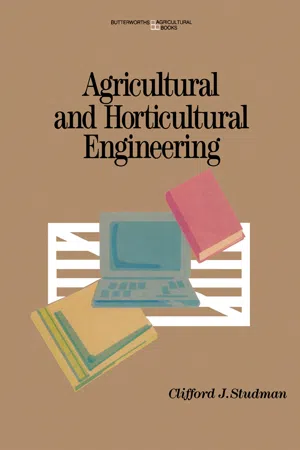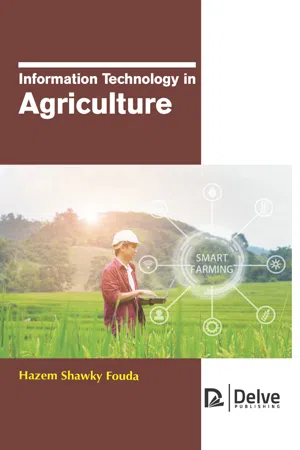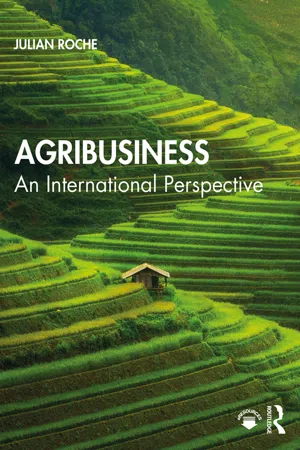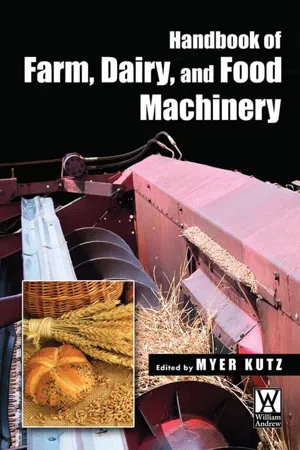Technology & Engineering
Agricultural Engineering
Agricultural engineering involves the application of engineering principles to agricultural production and processing. It encompasses the design and development of machinery, equipment, and structures used in farming, as well as the management of natural resources and environmental protection. This field plays a crucial role in enhancing the efficiency, sustainability, and productivity of agricultural practices.
Written by Perlego with AI-assistance
Related key terms
1 of 5
6 Key excerpts on "Agricultural Engineering"
- eBook - PDF
- Bonnie A. Osif(Author)
- 2016(Publication Date)
- CRC Press(Publisher)
61 4 Agricultural and Food Engineering Kathy Fescemyer and Helen Smith INTRODUCTION Agricultural.engineering.is.a.multidisciplinary.profession.that.relies.on.expertise.in.both.the.engi-neering.and.the.agricultural.fields . . The. roots. of. agricultural. engineering. go. back. to. the. earliest. civilizations.with.the.origin.of.the.hoe,.early.irrigation.systems,.and.other.early.farming.methods . . Over.time,.advances.in.agricultural.machinery.resulted.in.more.efficient.crop.production;.irriga-tion. and. drainage. developments. produced. more. usable. land. resources,. while. conserving. natural. resources;.advances.in.agricultural.buildings.resulted.in.a.healthier.environment.for.livestock.and. increased.efficiencies.in.crop.storage.and.production;.and.the.use.of.electricity.on.the.farm.made. possible.the.automation.of.many.farm.processes.(Isaacs,.2003) . .Food.engineers.were.also.devel-oping.advances.in.food.processing.to.increase.the.safety.of.foods.with.cost.efficient.technology . . Research.in.the.heating,.refrigeration,.drying,.chemical.preservation,.and.packaging.of.food.has. advanced.the.development.of.these.areas.(Farkas,.2003) . .The.importance.of.alternative.energy.has. initiated.numerous.studies.in.the.area.of.biofuels.and.bioenergy . .Research.has.also.shifted.toward. the.molecular.level.with.interdisciplinary.work.between.engineers.and.biologists,.geneticists.and. nanotechnologies.(Ochs.and.Patterson,.2002) . Prior.to.1907,.engineering.for.agriculture.was.done.by.mechanical,.architectural,.electrical,.and. civil.engineers . .As.a.profession,.formalized.agricultural.engineering.began.with.the.initiation.of. the. American. Society. of. Agricultural. Engineers. in. 1907 . .The.scope.of.agricultural.engineering. has.grown.and.evolved.over.time . .The.society.is.now.the.American.Society.of.Agricultural.and. Biological. Engineers. (ASABE). and. defines. the. profession. - eBook - PDF
Agricultural and Horticultural Engineering
Principles, Models, Systems and Techniques
- Clifford J Studman(Author)
- 2013(Publication Date)
- Butterworth-Heinemann(Publisher)
The Horticultural or Agricultural Engineer does not fit well into this sub-division of the subject, since his or her range of interests covers all of these areas. It is better to define Agricultural Engineering as: the application of relevant engineering to agriculture and horticulture. This means that we will need to consider any part of engineering which is relevant, be it electrical, mechanical, chemical or civil. We will also need to consider how this can be applied to agriculture and horticulture, and so we need to have some knowledge about agricultural and horticultural systems in order to be able to apply the information. It is possible to identify key areas in 16 The modelling approach 1.3 Horticultural and Agricultural Engineering which have evolved over time. In essence one can identify the areas of soil and water, power and machinery (or mechanisation), and structures. Food engineering can also be classed as another area if off-farm activities are included under the title of agriculture. 1.2 MODELS OR PRACTICALITIES? In a subject such as horticultural or Agricultural Engineering, there is always a slight conflict between the need to understand what is going on and the need to get the job done. There is a strong temptation to get on with the job, acquiring the minimum of knowledge necessary to complete the work. If this approach is taken then Engineering can become a series of practical hints about how to achieve an aim, and very little understanding results. The difficulty with this is that it is not easy to develop new ideas or to adapt to change. Once methods and techniques become outdated the individual has to relearn his or her skill from the beginning. A person who can use and understand the theory (ie, the model) behind a phenomenon is able to adapt to change, and can develop new things. All this is very good, but unfortunately theories also have limitations. - eBook - PDF
- Hazem Shawky Fouda(Author)
- 2019(Publication Date)
- Delve Publishing(Publisher)
Agriculture Engineering and Information Technology 3 CONTENTS 3.1. Introduction ...................................................................................... 50 3.2. Use of Information Technologies In The Field of Agricultural Engineering ................................................................ 52 3.3. Motivation For The Usage of Information Technology In Agricultural Engineering ............................................................. 57 3.4. Drawbacks of Traditional System of Agricultural Engineering ............ 58 3.5. Certain Risks In The Field of Agriculture Engineering ......................... 60 3.6. Adaptation of Information Technology In Agricultural Engineering .... 62 3.7. Different Forms of Futuristic Information Technology That Are Used In Agriculture .................................................................. 65 3.8. The Importance of Modern Agricultural Technology and Its Adoption ............................................................................ 67 References ............................................................................................... 69 Information Technology in Agriculture 50 The use of information technology (IT) in the field of Agricultural Engineering has become a beacon for the farmers who have been struggling with the drawbacks of the trends and practices of conventional farming. It is very important to make the farmers and the agriculturists expert in the implementation of the IT in the field of Agricultural Engineering in the modern world. The usage of the modern techniques of IT in the Agricultural Engineering has led to the revolutionization of the entire concept of the farming. The usage of the vehicles, different methodologies and techniques have helped not only the farmers but also the consumers who are receiving the end-product. - eBook - ePub
Agribusiness
An International Perspective
- Julian Roche(Author)
- 2019(Publication Date)
- Routledge(Publisher)
CHAPTER4
The role of technology
Introduction: a difference in approach
I imagine that most readers of this book are interested in the business of agriculture, in one or more capacities of regulator, lender, investor, supplier or adviser. It is always necessary to decide, even for scientists and certainly for business people, what research is needed, and for what purpose, and then to select only the latest and/or most relevant research. Agricultural scientists are often, it must be recognised, not especially well versed or even interested in economics or finance. Even basic concepts such as cost-benefit analysis are often alien, whilst on the other hand scientific jargon is rife. The best way to approach the dichotomy between their vast experience, dedication, research and achievements, and their oft-evidenced disinterest in finance, is to regard agricultural research as a data resource for financial decision-making. Certainly, the application of agricultural science has major financial impacts. This chapter has been written as an introduction to agtech and agricultural science with that aim in mind.Principles of agricultural science and technology
What is agricultural science? Agricultural research – the Australian government tells us – is not an actual scientific discipline in its own right. Rather, it is a broad term to describe the application to agriculture of many different scientific disciplines and endeavours, combined with the objective of achieving improvements in agricultural output, sustainability and, sometimes, profitability. Primarily, but perhaps regrettably, agricultural science integrates scientific disciplines in which research may have been carried out without an explicit end-point application. Traditionally this has involved all of botany, zoology and soil science including, inter alia - Akansha Singh(Author)
- 2019(Publication Date)
- Society Publishing(Publisher)
The importance of technology in agriculture gives a dynamic force for world’s development-an economic backbone. 5.3.1. Use of Machines on Farms Nowadays, the farmers can use machines for cultivation so they do not Digital Technologies for Agricultural and Rural Development 128 require more labor for doing agriculture farming and majorly it can cultivate more than 2 acres of land. It has been one-time investment for bringing new equipment’s for doing farming which also cut costs with less labor. But, the machines like tractor needs some maintenance costs but it is still very useful for the agriculture farming. Agricultural machines have been designed for practically every stage of the agricultural process. They include machines for tilling the soil, planting seeds, irrigating the land, cultivating crops, protecting them from pests and weeds, harvesting, threshing grain, livestock feeding, and sorting and packaging the products. People who are trained to design agricultural machinery, equipment, and structures are known as agricultural engineers. The process becomes so easy with the use of harvesters and planters. Production as well as time are equally important in the agriculture process like the farmers have to plant at the time and it not means that when the consumer will demand that only they are planting and harvesting, but it is the duty to do perform the activities on time and harvest in time and deliver to multiple stores in time. The new technology has allowed the farmers to produce more quantity of food in a shortest period of time with less involvement of less people or farmers. 5.3.2. Modern Transportation Modern agriculture requires modern transportation which helps in delivering the agricultural products on time. Sometimes, the demand for the particular product will decrease, but it doesn’t’ mean that it should not be available in the market. It comes directly from the farm to the market with the help of modern transportation.- eBook - ePub
- Myer Kutz(Author)
- 2007(Publication Date)
- William Andrew(Publisher)
This position requires a degree in engineering and five or more years of work experience. Of this work experience, three years must be within the food industry. Experience in product development is desired. Experience as a process engineer, production manager, production supervisor, or research and development engineer is highly desirable. Up to 50% domestic travel is required.Based on these job descriptions, the following engineering key words were found with major frequency in descending order: engineering, development, manage, design, analysis, concept, solving, and scale.These key words can be compared to knowledge and skills to be taught at universities offering engineering degree majors, including food engineering. Take the following, for example:• Students specializing in food engineering learn to apply engineering principles and concepts in handling, storing, processing, packaging, and distributing food and related products.•Students specializing in Agricultural Engineering integrate engineering analysis and design with applied biology to solve problems in production, transportation, and processing of agricultural products. Agricultural engineers design machinery, processes, and systems for managing the environment, nutrients, and waste associated with productive plant and animal culture.Figure 1.1 demonstrates a general flow diagram illustrating unit operations or processing steps typical of a food processing facility. The knowledge and skills of a food engineer can be applied in an integrated approach or in a more specific way, such as heat transfer in heating and cooling operations.Figure 1.1 General flow in a food processing plant(adapted from Heldman & Singh, 1981 ).As food is received into the food processing plant, it may be in a liquid or solid form. If it is a liquid, one of the primary considerations may be its classification as a Newtonian or non-Newtonian liquid, therefore the field of rheology should be part of the knowledge base of the food engineer. Rheological studies may provide the necessary information to the design of mixing machinery, piping, and even cleaning and sanitation of tubes and pipes used in transporting a fluid from one location to another.
Index pages curate the most relevant extracts from our library of academic textbooks. They’ve been created using an in-house natural language model (NLM), each adding context and meaning to key research topics.





